Are you ready to implement an analogy-based phonics program with your students? If so, your first step is to check out my last blog post, Everything You Need to Know About Analogy-Based Phonics.
Thinking about developing your own program? Be sure to read these suggestions!
How to Start Teaching Analogy-Based Phonics
Follow these 6 tips!
- Make it explicit and systematic. Yes, it can be teacher-directed. Teach a predetermined set of letter-sound relationships in a clearly defined sequence. I love this blog post, Synthetic or Systematic Phonics, by Shanahan on Literacy.
- Base your program on common spelling patterns. Wylie and Durrell identified 37 spelling patterns or phonograms in 1970. These phonograms can be found in nearly 500 primary-grade words. Edward Fry created a list of the 38 most common phonograms in 1998. There are more than 600 one-syllable words with these phonograms. Find a list of these phonograms in Teaching Analogy Phonics (ATLAS, 2016).
- Use a consistent set of key words. I read a suggestion to let your students choose their own key words based on their individually known words. Hmmm… not my students, but perhaps yours! I suggest picking a consistent set of high-frequency words as your key words.
- Teach grapheme-phoneme relationships. Don’t just teach your students that -ack stands for /ack/. Break it down. Teach them that the letter a stands for /a/ and that the two letters -ck together stand for one sound /k/.
- Be sure your students are ready. Your students should recognize most letters and be able to produce their corresponding sounds. They need prior exposure to producing rhyming words They should have some experience with blending and segmenting onsets and rimes as well as 3 phonemes.
- Model how to use the decoding by analogy strategy. Give your students plenty of opportunities to apply the strategy. Provide a variety of text including poems, decodable readers, and leveled books.
Thinking you’d rather start with a ready-to-go program? Keep reading!

Keys for Decoding: An Analogy-Based Phonics Program
Would you like a phonics program designed for kindergarten and first grade that:
- helps you teach decoding and encoding skills?
- is explicit and systematic?
- provides detailed lesson plans for you?
- has built-in visual supports for your students?
- helps students who struggle with blending and segmenting individual phonemes?
Well then, this teacher-directed analogy-based phonics program is just right for you! Get ready to have your students use words they know to read and spell new words!
What Do I Need to Know?
This program is based on 46 spelling patterns (rimes, phonograms, word families) drawn from the high utility/ most common lists compiled by Wylie and Durrell and by Fry.
Each spelling pattern is represented by a key word. Each key word has a corresponding picture that shows its meaning. The pictures provide visual cues to support learning.
The patterns covered are:
- vowel-consonant (VC),
- vowel-consonant-consonant (VCC),
- vowel-consonant-e (VCe),
- vowel-vowel (VV),
- one r-controlled pattern, -ore.
The program focuses on one-syllable words without prefixes and suffixes.
The sequence is fixed in this cumulative program.
All materials are either black/ white or color with a black/ gray/ white option.
You can download a free sample of my Phonics Program for Analogy-Based Decoding to try it before you buy it! Keep reading to find out more!
How Can I Use This Analogy-Based Phonics Program?
You can implement this phonics program in:
- a whole class or
- a small group setting,
- a general education or
- an intervention setting.
You can adapt the pacing and setting to address your students’ instructional needs. I include ideas for compressing or extending the lessons.
The core of the program is based on 3 days of lessons for each key word. Each lesson includes a variety of activities for reading and spelling.
Allow 45 minutes per lesson until you determine the amount of time (less or more) that works for your class/ group.
What’s Included With Keys for Decoding?
All printable materials for teaching the lessons are included in the program. These are teacher-directed activities. I provide detailed lessons with ways to support student learning.
- Teacher Information
- Detailed Lessons for the 46 Key Words
- Worksheets and Recording Sheets
Supporting Materials Including:
- Wall Charts
- Strategy Bookmarks
- Word Wall Headers
- Key Word Cards
- Word Cards
- Picture Cards
- Onset and Rime Cards
- Word Lists
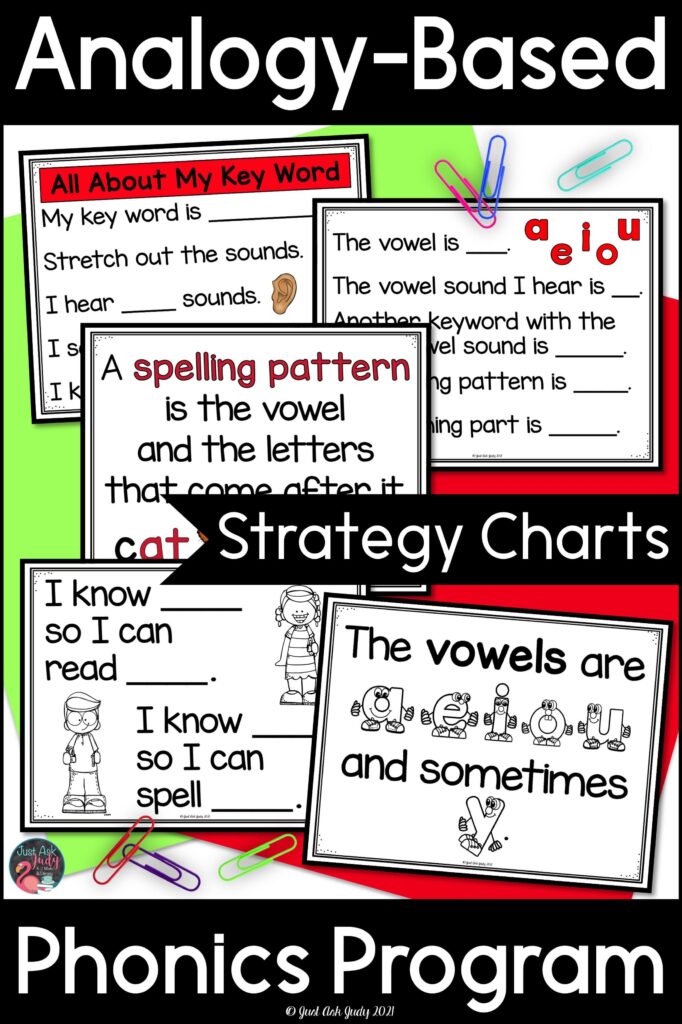
What Else Will I Need to Teach This Analogy-Based Phonics Program?
Your students will need basic classroom supplies such as pencils, highlighters, scissors, and glue.
You’ll need paper, cardstock, and laminating film to prepare the materials plus space for a word wall. You’ll also want a chalkboard, a whiteboard, or large chart paper; and a pocket chart.
Most importantly, you’ll want to provide a variety of text for your students to read in small guided reading groups. They’ll need plenty of opportunities to apply the decoding by analogy strategy while they’re engaged in reading text.
When I was in the classroom, I collected poems from various poetry books for each of the spelling patterns I taught (think summertime leisure activity). I wrote them on large chart paper for my students to read chorally and to highlight the patterns. You can’t imagine how popular highlighter tape was!
I also printed individual copies for my students to highlight and keep in a poetry notebook. What a handy source of reading material!
What About the Lessons?
There are 3 days of lessons for each key word. Support for success is built into each lesson and activity!
Day 1
- Introduce the New Key Word- This is a teacher-directed auditory and visual activity that includes segmenting the sounds and mapping the sounds you hear to the letters you see.
- Generate and Read Rhyming Words- Students brainstorm words that rhyme with the new key word. Follow-up by having your students write the words (an optional activity).
- Read Sentences- Find and highlight words with the new spelling pattern. Read sentences with the new spelling pattern.
- Sound Letter Match (Spelling) Students segment the sounds they hear in key words. They write the letter or letters that stand for each sound in a box.
Day 2
- Review Key Words- This is a group, choral activity.
- Blend and Read- Use onset and rime cards to create and read words with the new spelling pattern. Choose from 3 options.
- Keys to Spelling- Students use key words to spell new rhyming words.
- Rhyming Word Sort- This is a cut and glue sorting activity. Students highlight spelling patterns in new words. They cut out and glue the new word cards in columns under their key words with the same spelling patterns. Then, they use the key words to read the new words.
Day 3
- Review Key Words- This is a group, choral activity.
- Snap, Clap, Stomp, or Not or Where’s the “Teddy Bear”?- Two more ways to get your students reading words with their new spelling pattern. Plus, who can pass up a chance to move and make noise!
- What Do I Hear? (Spelling)- Students listen for the rhyming part of new words. They think of the key word with the same rhyming part to help them spell the new word.
- What’s My Spelling Pattern?- Students highlight the spelling pattern in each new word. They write the key word with the same spelling pattern under each new word. Then, they use the key word to read the new word.
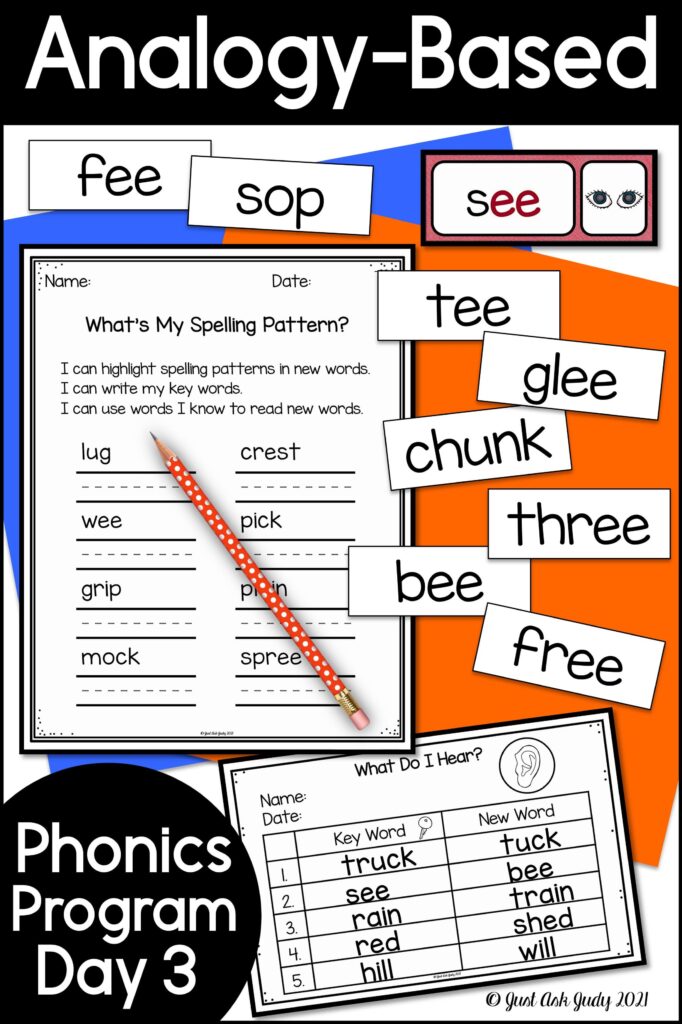
Ready to give it a try? The free sample of my Phonics Program for Analogy-Based Decoding has everything you need to teach the first two spelling patterns.
Want to jump right in with both feet? Purchase the complete analogy-based phonics program with all 46 spelling patterns or the program limited to the first 17 VC spelling patterns from my TpT store. Be sure to click the green “View Preview” button to get a closer look at each product.
Phonics Activities for Analogy-Based Decoding
You don’t want to forget the fun stuff!
Do you have students who would benefit from engaging in additional reading and spelling activities that supplement these lessons?
Then, my add-on sets of reading and spelling activities are exactly what you need! Your students will get plenty of practice using words they know to read and spell new words with these reinforcing activities.
The activities can be used in small groups, in centers, or as independent work to reinforce the skills being taught.
These activities can be used during the 3-day lesson cycle of my Keys for Decoding Analogy-Based Phonics Program or used to expand those lessons to a 5-day cycle. They are the perfect addition to help you address the needs of students with learning challenges or to just add a little variety and fun.
Go ahead and peruse the description and preview for my Phonics Activities for Analogy-Based Decoding for all 46 spelling patterns or the first 17 VC spelling patterns.
What else would help you to get started teaching with an analogy-based phonics program or approach? Let me know in the comments below!
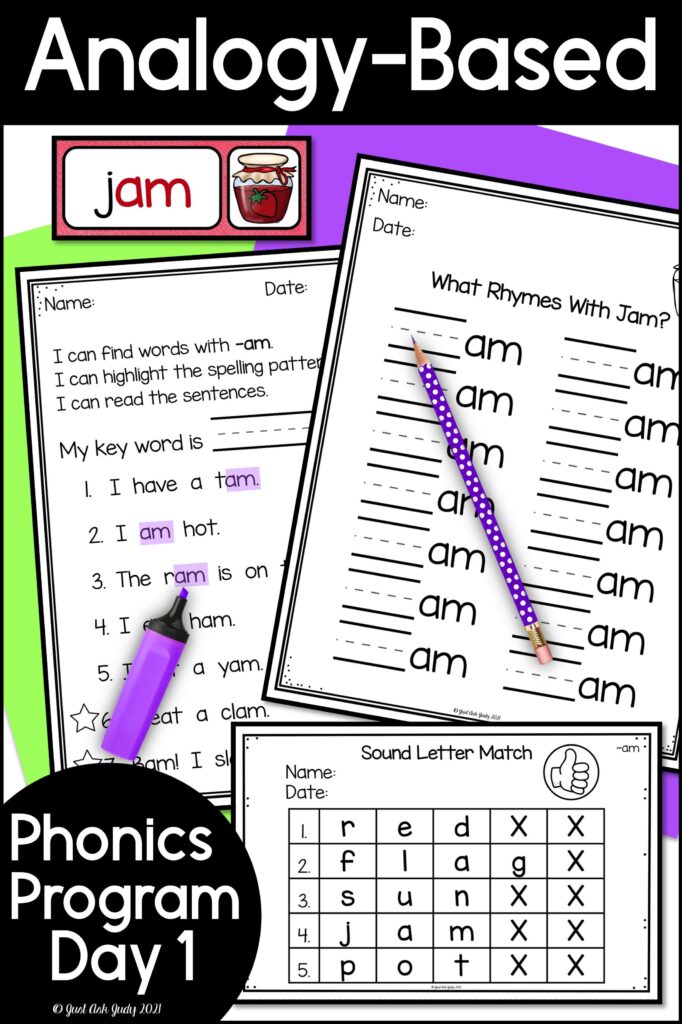
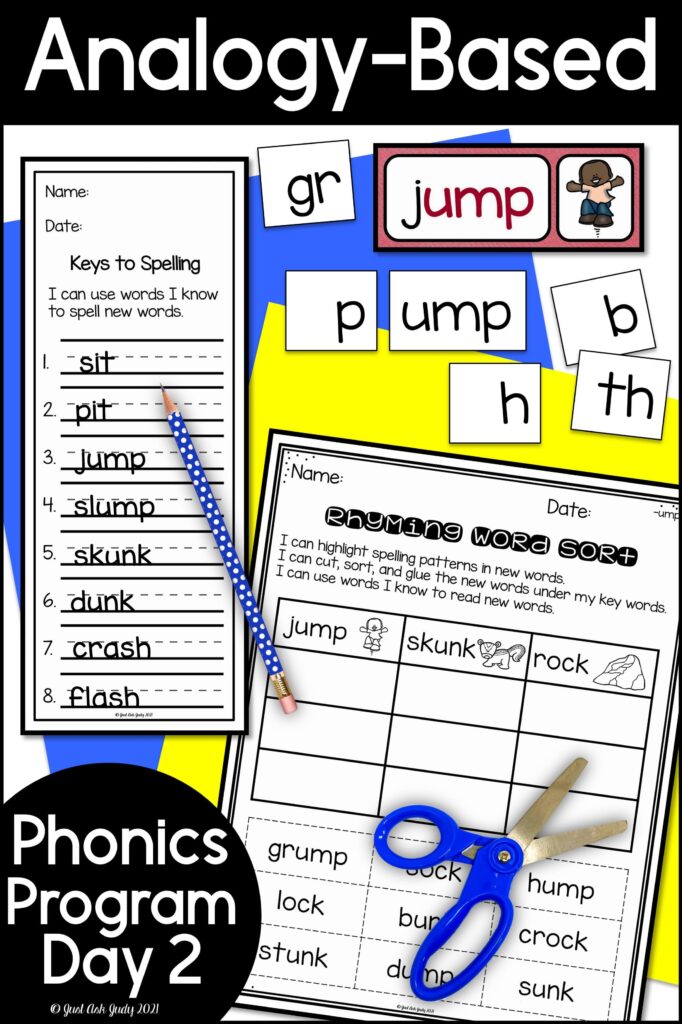
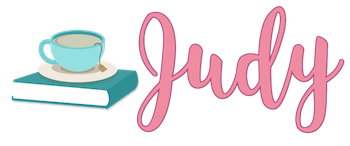
Leave a Reply